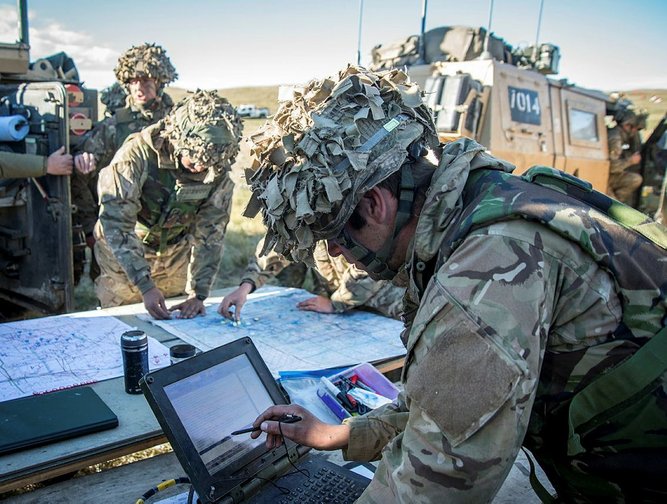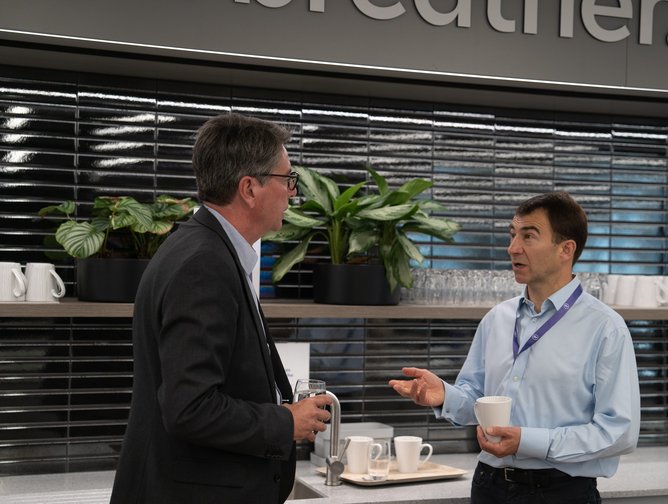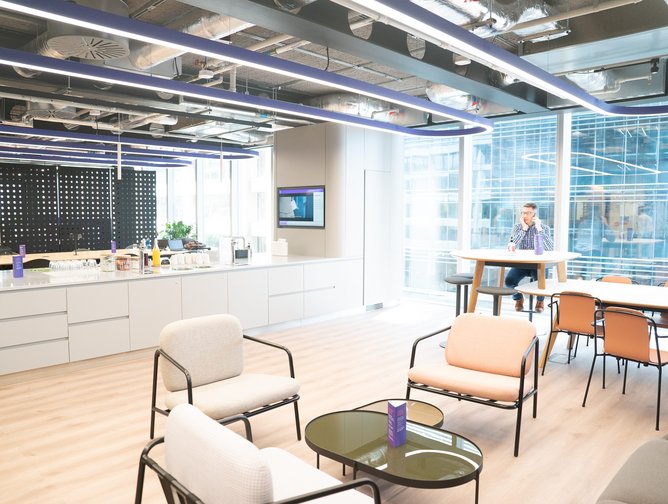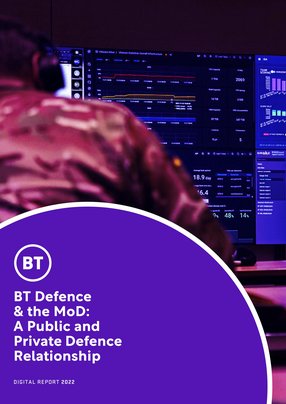BT Defence & the MoD: A Public and Private Defence Relations
A lot of people aren’t aware that the army runs an external placement scheme for officers at ranks and that such schemes can act as bridges between the private sector and the traditionally public world of defence.
The technical knowledge and expertise gained can run in both directions, thereby strengthening both sectors and propelling strategy and development, providing mutual benefits to defence as a whole. Jonathan Cole, CB, OBE and Director of Defence at BT, is one of those bridges and, due to his extensive knowledge and expertise, is an important asset to BT.
“I took part in the placement scheme as a fairly senior officer,” he says, “as I was a Brigadier who was about to be promoted to Major General, and for six months, I had the opportunity to come and work for BT.”
At that time, Cole worked in the Technology unit of BT rather than where he is now – in its Enterprise business, which is one of the customer-facing units. “I really came here to have a breath of fresh air, to learn about the commercial world and about some of the technologies that are out in the commercial sector that defence was potentially not utilising. In many ways, it was a chance for me to understand another large enterprise with a lot of parallels to the Ministry of Defence MoD.”
Some find it conceptually challenging to think about defence in terms of the private sector – and even more so when it comes to the relationship between the public and private sectors in this regard – but the parallels between them are striking enough, and the potential reciprocity significant enough, to force them to rethink their long-held biases.
“When I look at BT and the Ministry of Defence (MoD), roughly speaking, they've got a similar sized workforce: both have a global footprint; and both, of course, also have all the advantages and disadvantages of being large organisations,” says Cole.
“For me, it was a really valuable learning experience on how to operate and thrive inside a large organisation. The focus of my secondment was really to prepare me for my next job as the Army Chief Information Officer (CIO), and, at that time, it didn't really occur to me that I would end up working at BT. But actually, as it happened, I had to sign a contract – as did BT – with the understanding that they wouldn't try to recruit me (and that I therefore wouldn't leave the army) within a given time period, in order that the MoD got a return on the investment of letting me go for six months.
Cole joined BT seven months ago, having spent a full military career in the British Army. He was a Major General and had joined the Royal Corps of Signals (the Army's specialists in IT, Cyber and Information). Towards the end of his military career, Cole was the CIO for the Army, working at board level – involved in strategic-level decision making – as well as programme leadership and delivery.
Now at BT and running BT’s Defence team, his expertise in light of the cyclical nature of IT, Cyber and Information in relation to the ever-integrative public and private sectors renders him a fine asset for the position.
“I have a team of people in BT who are established to be really customer-facing, focused on the MoD as our customer, but drawing from the wider Enterprise business in order to deliver the products and services to meet our customer needs,” he says. “What I find really exciting is that, having grown up in defence and spent a full career there, I principally, passionately believe in the outputs and the outcomes of the MoD. So, even though I'm in my second career, I now find an opportunity to keep contributing, and our role is really to deliver and operate a whole range of IT services to the MoD.”
It's known that Cole holds personal accountability and responsibility for operational excellence in his role, as well as for the profits and losses of service delivery and future business sales.
Nevertheless, he says: “What I love about my job is that I have an end-to-end responsibility for which I'm held accountable by the company for delivering to our customers across the spectrum of live service delivery and operations, future programmes in-flight – including change management – and looking for future business opportunities, as well as ways in which we can help and partner with Defence (and with other people in the defence community) to deliver the sorts of IT services that the MoD desperately needs.”
Over the last 20 years, BT has predominantly been delivering to the MoD through two main contracts: the Defence Fixed Telecom Service (DFTS) and the Integrated User Service (IUS). Both of these programmes, along with other programmes delivered by other industry-partners, contribute significantly towards what the MoD now calls the ‘Defence Digital Backbone’ (DDB).
“This,” says Cole, “is really a coalescence of Technology, People, Data, Business Processes and Operating, and, of course, the use and management of data – and allowing data to be the central aspect of Defence's business.”
With the exponential growth of big data and technological development, along with all of its ramifications for security, there is a marked increase in the emphasis on data-centrism in the Defence industries. This stands to reason.
Cole says: “BT has been part of that journey as it has in many ways, really moved from being a traditionally telecommunications focused company to trying to work further up the stack and understand how we can help our partner to make that journey to data-centricity, and, of course, doing that in the context of significant cybersecurity threats.”
“We are already very much a trusted partner of the MoD, and are one of its major suppliers,” he continues. “The two major programmes that we work on at the moment – the DFTS and the IUS – will eventually come to a natural end, and the MOD will recompete and run for new business. Naturally, we wish to be in the running for future business and by no means take that for granted. What we seek to do is partner with defence and, where appropriate, the wider network of partners out in the defence industry – as well as the wider commercial environment – to deliver the successor programmes for those in parallel to that.
“BT recently launched a new Charter for its Enterprise customers to provide them with a springboard for growth. This will be delivered through a greater focus on innovation, world-class cyber security, a new suite of digital services, customer service improvements and purpose-driven goals. For example, we recently set up the Division X unit within BT’s Enterprise business, which will accelerate the development of customer solutions which integrate emerging technologies such as 5G, IoT, Edge Compute, Cloud and AI.
“I also think that our Defence team needs to exploit the opportunities for that. An example might be Private 5G Networks to enable Internet of Things (IOT) solutions to be deployed and find business opportunities for our customers, which can improve either their productivity, efficiency, operational outcomes or their security. There's all sorts of use-cases to do that, and we want to be part of that journey. We want to move ourselves into an environment where we can exploit the technologies available and help the customer to really move on its own digital transformation.”
As with a lot of organisations, BT’s Enterprise unit has a small business development team working on defence. They also have a sales team that includes account managers and a frontline command-facing customer engagement team.
“So, we have people that run the accounts-facing Army, Navy, Air Force and Strategic Command – the four key pillars of the MoD; we're not just focused on a centralised part of defence, but are working with our customers and helping them across all pillars, from a sales perspective.
“Additionally, we have all of the enabling functions. We're a very functional model in BT. So I depend on Contract Management, Financial, Legal, Project Delivery, Service Operations and Security – a whole, wide ecosystem, all of which is underpinned by technology experts who are, for example, Solutions Architects who work out of our research labs in Adastral Park near Ipswich, where we are able to bring cutting-edge technologies to our customers.
“There’s a really large matrix of people across BT working towards those outputs.”
BT’s defence security strategy and how it excels in its approach
Strategically, BT is working very closely with, and gaining an understanding of, the MoD Chief Information Security Officer's strategy, as well as aligning itself with the policies and protocols of the National Cyber Security Centre. This is so that they can ensure that they are firstly, compliant, but also that their customer has confidence in the services and products that they provide: protecting data and making it available for those that need it in order to conduct their operations.
“We work very closely with BT’s security team,” says Cole. “There is a whole operating division inside BT who actually look after security for all sorts of organisations, globally. It's not just Defence for whom security is important, and the MoD is, in many ways, mirroring some of the really good practices in other sectors.”
BT’s vertical business unit and its ramifications for Defence
Cole expresses that, during his time in defence, they had a really two-dimensional model where, in many ways, the single services were more powerful than the individual functions within BT.
“My observation in my last two or three years in the MoD was that it was, however, shifting to an increasingly functional model – although it still retains a very strong, single-service organisational approach (Army, Navy, Air Force and Strategic Command).
“By contrast, what I've observed at BT is that whilst we have our own Chief Executive Officers for each of the customer-facing units (such as inside BT Enterprise where I work, BT Consumer and BT Global – and also Openreach, which is separate for regulatory reasons) – the other customer-facing units, the enabling organisations of Digital Technology and the corporate sections have a really strong thread of a functional model running throughout them.
“What this means for me is that I'm able to pull from a best-of-class team of people who are doing programme-delivery and excellence. Another area would be our Operations Team, who are, I believe, a real centre of excellence for best-practice, not just across the defence customer but all of our customers. This means that I'm supported by leaders in each of those functions to deliver specialist advice, products and services to my defence customers.”
“The trick is to make sure that I collaborate closely with the Directors of those functions so that we share a collective sense. “This means that people are supported by their function, but also that they have a sense of ownership and equity in our outputs and outcomes – and I have the privilege to be able to coordinate those activities.”
Technology transformation at BT
Howard Watson, the Chief Technology Officer for BT, worked very closely together with us to drive digital transformation across the company. Now, the company is increasingly looking at how it can go cloud-first with many products and services, and also explore strategic partnerships in order to deliver cutting-edge technologies.
Another beneficial aspect of the relationship are the research and development labs located at Adastral Park, where they're able to develop patents – many of which have recently been placed around Artificial Intelligence as well as the visualisation around AI focused on Cyber Security.
“We have people who are world-leading experts, who are invited to speak at conferences around the globe, and to write academic articles around some of these topics,” says Cole.
“Now, of course, a lot of this is protected by intellectual property rights, but as a company, we’re able to take those technologies and put them into our own internal transformation. The most important thing is to find out how we can use that to partner with our various customers along our vertical segments to actually drive those products and services into their businesses and help them deliver their own digital transformation outputs.
“So, in the defence context, what we need to do is to work very closely at defence level with the MoD’s Defence Chief Information Officer, as well as with the Single Service Chief Information Officers, regarding their individual and collective transformations, to make sure that we’re partnering with them to ensure that they can get the best value for money, the highest productivity and can really be cutting-edge, delivering quicker, faster and cheaper – which I think is what any taxpayer would ask for.”
BT’s digital community
In working closely with BT’s Digital unit, we are subsuming experts from inside of BT Digital – as they have digital consultants – who support them in working with customers on use-cases and understanding the relevant personas around those use cases.
“Whilst you might be able to reuse and refactor a lot of the products and services across defence, there will be some particular nuances,” Cole says. “What we're trying to do is make sure that we are partnering with our customers in that as well.
BT’s approach is to pull the best expertise from the company, analyse other verticals, and then place them into the hands of the user, get their feedback, and then iterate. Another example of a vertical they’ve taken best-practice from is in health.
Cole says: “One of my colleagues is focusing on helping the NHS to digitise, and I think there's some really good ideas of what they're doing to help provide cutting-edge technology into the NHS. Some of that can be reused within health organisations inside the Ministry of Defence.”
Enterprise Architecture
BT has Enterprise and Solution Architects who work at different layers across their programmes.
“What we need to increasingly do is work closer with the Defence Enterprise Architecture Team, and I think that's growing – but there's still a lot of work to be done in that regard with our customer; we're trying to ensure that we have alignment there,” says Cole. “When our existing programmes are being modified, we need to make sure that's coherent with the principles of a decent architecture around enabling open standards to make sure that there’s reuse of components where possible, that security is built-in by design, and that it's both data-centric and user-centric.”
So, BT has to make sure that they’re providing solutions that will match the architecture in Defence, which requires a real understanding of the whole breadth of the Defence-IT ecosystem yet can be very large and complex.
“But with a strong team of architects and the people in my team with in-depth defence knowledge – many of whom have either served in Defence like I have, or who've worked with the Defence customer for 20 odd years – they of course understand the environment really well. It's all about collaboration and implementation of our experience.”
BT provides data and networks across all sectors. “If anybody's a fan of premiership sport, they will probably find a lot of the sport that's getting to them is media and broadcast from BT. We take data and insights from that. We look at the network performance, we look at latency, and we have resilience plans so that if, for example, a link drops, there's another link immediately available. What we need to do is to take insight from live operations. We run analytics on that and also have visualisation there, as well as command centres.”
BT has a Networks Operating Centre and a network of Security Operations Centres across the globe, providing ‘follow the sun’ security services. They also have sub-components of these, based on particular customer environments. They then have the call-centres who deal with customer management, as well as on specific tactical issues, but behind the scenes, BT is looking at the data and insights for the performance of their networks.
Cole says: “We look at the Security threat landscape and at associated incidents. We work very closely with the National Cyber Security Centre and share incident reports and threat intelligence between our organisations. We also share this information with like-minded partners to help build our collective resilience against the ever-growing volume of cyber threats.”
Partnership, Collaboration and Fortinet
It can’t escape readers that Defence is not only bolstered but actually enhanced by collaboration and partnerships. The strength of such relationships is becoming ever more apparent, and the strongest and most effective organisations are those who, in every sector, are willing and open to collaboration.
Cole says: “Over the last two years, there's been a real growth in our smart bases, taking best practice from what BT has done elsewhere.
“A really good example is Belfast Dockyard, where we have enabled them to effectively digitise their operations and achieve amazing returns on their productivity. We have taken some of those technologies and we've worked with individual frontline commands – Army, Navy and Air Force – to also help them digitise in their smart bases. We've depended, of course, on partners to help us to do that. And, given the constraints on the global supply chain during the pandemic, in many ways, one of our greatest challenges to the critical path of delivery has been the availability of components.
“Our partner Fortinet has worked really closely with us as we've sought to roll out the smart bases. We have proofs of concept in place now with the Army, Navy and Air Force, and Fortinet has been a really key partner with us in delivering those proofs of concept – where, already, the customer is starting to realise benefits.”
The next 12 to 18 months are really crucial for BT’s Defence team. They have some major contracts coming towards their exit phase. They also have lots of potential new business coming their way, and presently have a major bid in, the outcome of which will become clear over the coming months, as well as other bids that they’ll be looking to work on in the near future.
“We are also working with other partners to support them in some bids that they're leading, and have lots of new business in the pipeline,” says Cole. “What we are recognising is that defence is changing the way that it's managing its business. It is increasing its use of frameworks, and is in many ways, disaggregating large contracts. We need to recognise how we can work into those, either through frameworks or through formal bids. In many ways, we're waiting for our defence customer to clarify what some of those programmes will look like in the future. I know that I will speak for many of my industry colleagues in anticipation of that. We are potentially waiting on opportunities and are really keen for defence to share with us, what those programmes look like, the shape of them, the way that they're disaggregated, when they'll come to market and by which commercial vehicles.
“We are ever ready to provide world-class products and services with our partners, and put them into that defence network.”




- OpenText AI: Empowering Businesses in Information ManagementDigital Transformation
- Microsoft in Japan: $2.9bn Investment to Boost AI & CloudCloud & Cybersecurity
- Google Cloud Next 2024: Pushing the Next Frontier of AIAI & Machine Learning
- Gallagher’s Tia Cheang to speak at Tech & AI LIVE LondonData & Data Analytics


